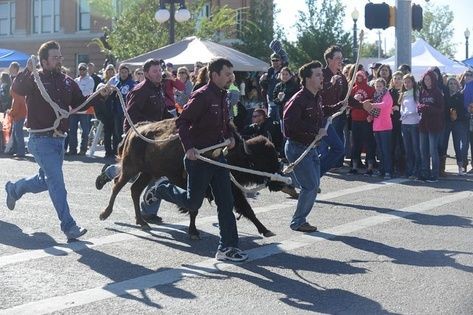
Downtown Canyon, Homecoming, From the WT Archives
Communities and the universities they host are married to each other. When one partner grows and prospers, so does the other.
This has been true for a long time. In European universities during the 1100’s, lecturers rented spaces in town and offered classes to students in various locations. In Paris, faculty shared teaching spaces on the Left Bank of the Seine River that eventually gave birth to the la Sorbonne in 1240, later known as the University of Paris. Instruction was in Latin, and the area became known as the Latin Quarter. The interaction of students and faculty with members of the extended host community was dicey. History confirms the ebb and flow of a myriad of marriages between universities and communities has been uneven.
Town-gown relationships in smaller rural communities, where the university may be the single largest employer, become even more important. When disregard toward the community by the university is present – and vice versa – relationships falter to the point of breaking.
And, of course, nobody wins.
Larger cities tend to absorb universities. Some urban institutions are so highly integrated they are indistinguishable from the metropolitan fabric creating a 21st century equivalent to the Latin Quarter.
The challenges of these relationships are not new, and are pervasive to this day in universities around the world. Kim Griffo, Executive Director of the International Town and Gown Association, suggests that off-campus student issues such as “housing, code enforcement, neighborhood relations which are still at the forefront of town gown relations” have been fertile soil for discontent.
One of the benefits of a powerful relationship between town and campus is that it is free. Communication, understanding and a desire to cooperate are the prerequisites. These relationship traits, unlike the bricks and mortar of a library, laboratory or a football stadium, rest on a sincere commitment to mutual service and few, if any, capital costs. It is a bargain with benefits. Experience tells me that the key ingredient of thinking ahead and planning is cooperation.
Even this cost is too high for some. The Princeton Review identified ten cities where town and gown relationships are strained. This top-ten list includes universities of every type in every setting – none are in Texas. The folks at Princeton review should have talked to the Canyon/Amarillo communities, university and school districts to see how cooperation for mutual benefit is working. However, there is no rest when chasing excellence.
Some university/community relationships are groundbreaking. St Lawrence University in Canton, New York, is the subject of study for a beneficial town and gown relationship. Factored into the equation for success are the quality of the K-12 schools, good healthcare, affordable daycare, attractive housing and a growing tax base.
The Campus Compact, a national organization of nearly 1000 college and university presidents, highlights service learning, civic engagement and community service as the glue of town-gown relationships. The intersection of university students and community, added to an evolving sense of the importance of public service, contributes to both student educational outcomes and community economic development.
A new, more positive face of opportunity might replace the cynicism of many towards government when students engage in community service. President Reagan had it right, “We can’t help everyone, but everyone can help someone.” Engagement, one person at a time, need not be “big” government but a big personal commitment that engages people and organizations, both public and private.
Strong university-community partnerships lead to growth in philanthropic endeavors. It seems alumni and other benefactors value a strong relationship between institutions and community service.
Establishing relationships with community-based employers provides the opportunity for student internships and productive work relationships that benefit students and the enterprises that host them. Shared visioning exercises can have a powerful effect on the health and prosperity of both campus and community. The University of Michigan at Flint and the City of Flint have worked diligently to create a robust shared vision.
I believe a conscious effort to build strong town-gown relationships increases economic vitality and offers valuable educational experiences for students. In addition, fruitful relationships between campus and civic leadership provide a strong voice to state government in expressing needs and aspirations in a geographic area through a resonating harmony rather than a cacophony of competing consternations.
The ingredients for a productive relationship are simple. Communicate regularly and often with leadership on a two-way street. Recognize that the health of one partner depends on the health of the other. Demonstrate sympathy toward important issues in both directions. When challenges occur run toward them, not away.
A productive town-gown relationship should be highly prized for the contribution it makes to the academic enterprise and learning experiences that benefit students and for the prosperity it helps create for the community.
Strong town-gown relationships create strength for both partners.
Just like a marriage.








The recent resolution of the Kimbrough stadium issue appears as a great t-g relationship between Canyon, through the Canyon Independent School District, and WTAMU. It seems as though these relationships take on greater importance for smaller communities. Regardless, both parties are to be congratulated in this win-win result.
The town and gown relationship is an important thing. There has always been a strong town and gown relationship between Canyon and WTAMU. That is why it’s surprising that the Homecoming parade has been moved out of downtown Canyon where it has been for years. (For the picture of cooperation between town and gown a photo of the parade in downtown Canyon had to be found in the archives) I grew up in Canyon and the parade was always a big event. I do not understand why the parade has been moved? Taking the parade out of its traditional setting in downtown Canyon is the opposite of town and gown cooperation.